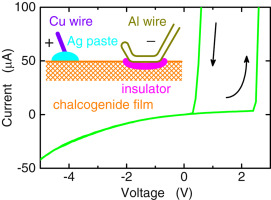当前位置:
X-MOL 学术
›
J. Alloys Compd.
›
论文详情
Our official English website, www.x-mol.net, welcomes your
feedback! (Note: you will need to create a separate account there.)
Interfacial resistance switching characteristics in metal-chalcogenide junctions using Bi–Cu–Se, Bi–Ag–Se, and Sb–Cu–Te alloys
Journal of Alloys and Compounds ( IF 5.8 ) Pub Date : 2020-05-01 , DOI: 10.1016/j.jallcom.2020.153880 Y. Takagaki , B. Jenichen , M. Ramsteiner , A. Trampert
Journal of Alloys and Compounds ( IF 5.8 ) Pub Date : 2020-05-01 , DOI: 10.1016/j.jallcom.2020.153880 Y. Takagaki , B. Jenichen , M. Ramsteiner , A. Trampert

|
Abstract Conduction properties of the junctions of chalcogenide alloys Bi–Cu–Se, Bi–Ag–Se, and Sb–Cu–Te with metals are investigated to examine the capability for realizing the interfacial resistive switch. Electrically reversible spontaneous generation of insulating interfaces can take place with Al in all the cases. Controllable resistance switching is thereby demonstrated to occur for a range of alloys that consist of group V elements, transition metals, and chalcogens. The sheet resistivity of the chalcogenide films changes orders of magnitude when the material synthesis temperature is varied. Optimum conditions for the resistive switch devices are explored with emphasis on slowly progressing interfacial chemical reactions that cause aging effects. The dependence on the synthesis temperature is examined further in terms of the structural and optical properties. In addition, the spontaneous interface reaction is confirmed using transmission electron microscopy.
中文翻译:

使用 Bi-Cu-Se、Bi-Ag-Se 和 Sb-Cu-Te 合金的金属-硫族化物结的界面电阻切换特性
摘要 研究硫族化物合金 Bi-Cu-Se、Bi-Ag-Se 和 Sb-Cu-Te 与金属的结的导电性能,以检验实现界面电阻开关的能力。在所有情况下,Al 都可以发生电可逆的自发绝缘界面。因此,证明了由 V 族元素、过渡金属和硫属元素组成的一系列合金会发生可控电阻切换。当材料合成温度变化时,硫族化物薄膜的薄层电阻率会发生数量级的变化。探索了电阻开关器件的最佳条件,重点是缓慢进行的会导致老化效应的界面化学反应。在结构和光学性质方面进一步检查对合成温度的依赖性。此外,使用透射电子显微镜证实了自发界面反应。
更新日期:2020-05-01
中文翻译:

使用 Bi-Cu-Se、Bi-Ag-Se 和 Sb-Cu-Te 合金的金属-硫族化物结的界面电阻切换特性
摘要 研究硫族化物合金 Bi-Cu-Se、Bi-Ag-Se 和 Sb-Cu-Te 与金属的结的导电性能,以检验实现界面电阻开关的能力。在所有情况下,Al 都可以发生电可逆的自发绝缘界面。因此,证明了由 V 族元素、过渡金属和硫属元素组成的一系列合金会发生可控电阻切换。当材料合成温度变化时,硫族化物薄膜的薄层电阻率会发生数量级的变化。探索了电阻开关器件的最佳条件,重点是缓慢进行的会导致老化效应的界面化学反应。在结构和光学性质方面进一步检查对合成温度的依赖性。此外,使用透射电子显微镜证实了自发界面反应。











































 京公网安备 11010802027423号
京公网安备 11010802027423号